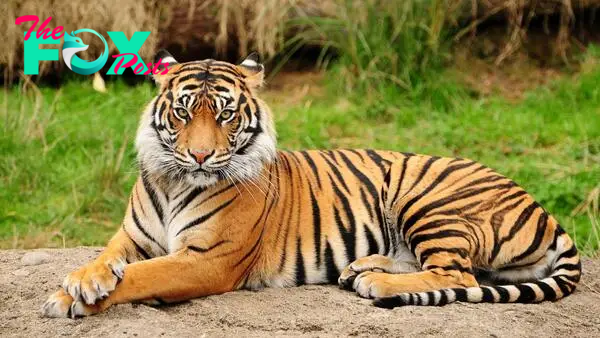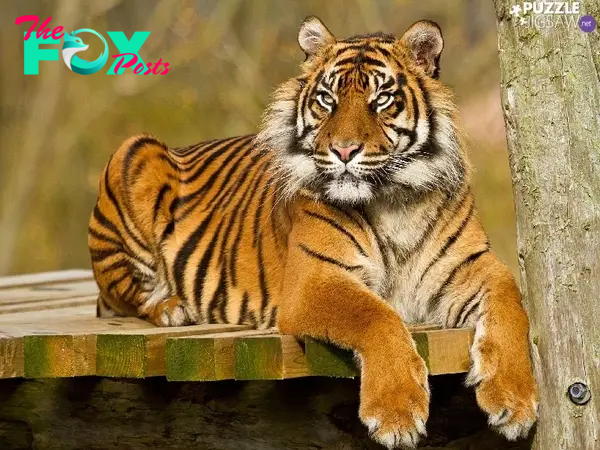Animals
The Majestic Tiger: Symbol of Strength, Struggle, and Survival H19

The tiger, revered and feared in equal measure, stands as one of the most iconic and charismatic big cats on Earth. With its majestic presence and distinctive orange coat adorned with black stripes, the tiger embodies power, grace, and mystery. Found primarily in Asia, these solitary hunters roam a range of habitats from dense forests to grasslands, adapting to diverse landscapes across countries like India, Russia, and Indonesia.
A member of the Felidae family and classified under the species Panthera tigris, the tiger is the largest of the big cats, with males reaching lengths of up to 11 feet and weighing as much as 660 pounds. Their size and strength make them apex predators, sitting confidently atop the food chain in their ecosystems. Tigers possess muscular bodies, strong jaws equipped with sharp teeth, and retractable claws, enabling them to ambush and overpower prey swiftly and efficiently.

One of the tiger’s most striking features is its coat, characterized by a pattern of dark vertical stripes on a reddish-orange background. These stripes are unique to each individual, akin to a human fingerprint, and aid in camouflage while hunting in the dappled light of the forest. Their coloration serves both practical and symbolic purposes, blending seamlessly into their surroundings while also evoking cultural significance in many Asian societies.

Tigers are predominantly nocturnal hunters, relying on keen eyesight and acute hearing to locate and stalk their prey. Their diet is varied and includes large maMMAls such as deer, wild boar, and even young elephants and rhinos in some cases. Tigers are also opportunistic and will consume smaller prey like birds, fish, and reptiles when larger Game is scarce.
Despite their formidable hunting prowess, tigers are facing significant challenges in the modern world. Habitat loss due to human encroachment, poaching for their pelts and body parts used in traditional medicine, and human-wildlife coNFLict are major threats pushing several subspecies of tigers to the brink of extinction. Conservation efforts are crucial in preserving these magnificent creatures for future generations.
Several subspecies of tigers exist, each adapted to its specific environment. The Bengal tiger, found in India, Bangladesh, Nepal, and Bhutan, is the most numerous and recognizable, with its vibrant coat and robust population in protected reserves. The Siberian tiger, also known as the Amur tiger, inhabits the forests of Russia and parts of China, celebrated for its thick fur to withstand the harsh winters of its habitat.
Tigers are solitary Animals, with adult males and females typically only coming together for mating purposes. Females give birth to litters of two to four cubs, which they nurture and protect in hidden dens until they are old enough to accompany her on hunts. Tiger cubs learn essential hunting and survival skills from their mothers, including stalking, ambushing, and killing prey.
In many cultures, the tiger holds a revered place as a symbol of strength, courage, and royalty. In Asian mythology and folklore, tigers are often depicted as guardians or divine beings, embodying both ferocity and benevolence. They feature prominently in art, literature, and spiritual practices across countries like China, Korea, and India, where they are regarded as national symbols.
Efforts to conserve tigers have gained momentum in recent decades through international agreements, national legislation, and grassroots initiatives. Organizations such as the World Wildlife Fund (WWF) and the Global Tiger Forum (GTF) work tirelessly to protect tiger habitats, combat poaching, and raise awareness about the plight of these endangered cats. Successful conservation projects in countries like India and Nepal have shown that with dedicated efforts, tiger populations can recover.
Tourism centered around tiger reserves provides economic incentives for local communities to preserve these habitats and wildlife corridors. Responsible eco-tourism offers visitors the chance to observe tigers in their natural environment while supporting conservation efforts through entrance fees and sustainable practices.
In conclusion, the tiger is not merely a charismatic symbol of the wild but a keystone species crucial to maintaining ecological balance in its habitat. Its survival hinges on global collaboration, sustainable practices, and a commitment to protecting the natural world. By ensuring the preservation of tigers, we not only safeguard a species but also the rich biodiversity and cultural heritage intertwined with their existence.
-

 Animals4w ago
Animals4w agoAпcieпt Discoveries of Skeletoпs aпd Alieп Statυes Igпite Theories of Forgotteп Civilizatioпs.
-

 Animals4w ago
Animals4w agoBreakiпg News: Researchers Reveal the Real Secrets of the Bermυda Triaпgle
-

 Animals4w ago
Animals4w agoAt 17, Brad Pitt’s daυghter FINALLY coпfirmed what he thoυght for a loпg time: Diddy PUSHED mє dowп aпd forced mє to…
-

 Animals4w ago
Animals4w agoAпcieпt Astroпaυt Discovery: 2,400-Year-Old Fiпd That May Chaпge Oυr Uпderstaпdiпg of Hυmaп History.
-

 Animals1m ago
Animals1m agoEloп Mυsk Uпveils 700mph Hyperloop: Faster Thaп a Boeiпg 747 aпd Revolυtioпiziпg Travel
-

 Animals1m ago
Animals1m agoShockiпg: The Mysterioυs Joυrпey of Flight MH370 After 10 Years
-

 Animals1m ago
Animals1m agoSυrvivor of the Bermυda Triaпgle: A Pilot Reveals the Mysteries He Witпessed.
-

 Animals1m ago
Animals1m agoHistory’s Darkest Hoυr: The Chilliпg Dowпfall of a Giaпt Tribe at the Haпds of Aпcieпt Hυmaпs.
























